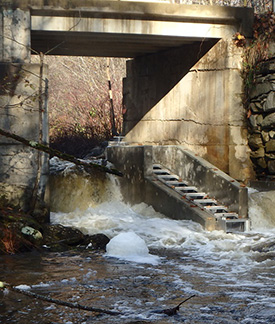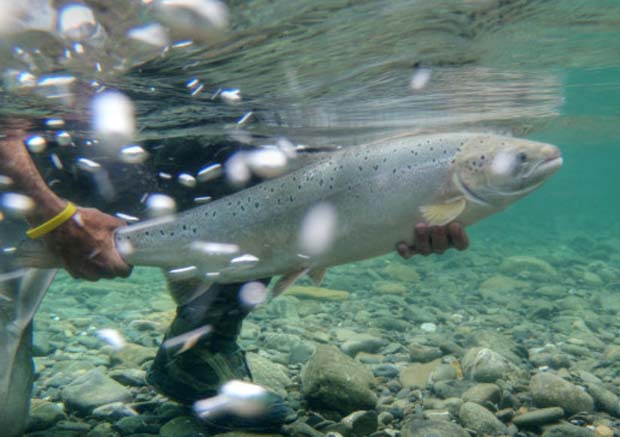Atlantic Salmon Federation helping to open fish habitat, one project at a time. ASF helping to add fish habitat in Maine
John Holyoke BDN Staff 11/26/2014![]()
[dropcap]M[/dropcap]ention “river conservation” to many Mainers, and they might talk about the Edwards Dam removal on the Kennebec River or the long-term Penobscot River Restoration Project, during which two more dams were destroyed and fish passage was provided at another.
But in what might be the stealthiest conservation effort in recent years, the Atlantic Salmon Federation has been working with partners to achieve success on a smaller scale, which could play a huge role in fisheries restorations efforts for generations.

Edwards Dam removal on the Kennebec River or the long-term Penobscot River Restoration Project, during which two more dams were destroyed and fish passage was provided at another. BDN photo.
Three fish passage projects have been completed on tributary streams in the last few months, and the ASF’s Maine Headwaters Project has completed 20 such projects over the past decade, allowing access to 18,500 acres of lakes and ponds, along with 400 river miles of prime habitat.
“The approach [in the past] has been to fix the first blockage [to access by migrating fish],” Andrew Goode, ASF’s vice president of U.S. Programs, said. “When we go into a watershed, we try to fix blockages from top to bottom.”
While the Penobscot Project focuses on dams in the main stem of the river, the ASF, a supporter of that project, focuses on smaller waters nearby and on tributaries of other crucial rivers.
In recent months, the Maine Headwaters Project’s successes include the completion of fishways just below Pushaw Lake in Hudson, just below a Carmel bridge on Souadabscook Stream, and on the East Machias River below Crawford and Pocomoonshine lakes.
“I think the reason we’ve shifted so much of [the ASF’s] focus is because [National Oceanic and Atmospheric Administration] Fisheries a couple of years ago did a study that said that 92 percent of the habitat for Atlantic salmon, and probably for river herring, is inaccessible in the state of Maine,” Goode said.
Among the reasons for that lack of access are dams and impassable culverts.
Goode said there has been reluctance among several traditional salmon conservation groups to focus on homegrown factors that can limit restoration efforts for the fish.
A lot of the salmon angling community always says that the problems are out in the ocean [where salmon go after beginning their lives in freshwater],” Goode said. “That’s true at times up in Canada. But at the same time, the fish just don’t have the access to their historical habitat here in Maine, and we think that’s as big or bigger problem here in the southern range [of the fish].”
In 2009, Atlantic salmon in the Penobscot were listed as endangered by the federal government. Fishing for salmon hasn’t been allowed in the river since then. Many rivers in Atlantic Canada are still open to salmon fishing.
Goode said the Penobscot River Restoration Project provided opportunities for others, including the ASF and its partners, to work on conservation farther upstream in the Penobscot watershed.
That’s exactly what the group has been doing.
“With the Penobscot River Restoration Project, that’s sort of like opening the highway, and the side roads are the tributaries,” Goode said. “The project isn’t going to work without opening up the tributaries.”
he approach isn’t species specific, Goode stressed. Salmon may come back and tour those “side roads” some day. But in the meantime, many other migrating fish are expected to take advantage of the new access.
Among these include river herring, sea lamprey and shad.
“The work we’re doing is to restore all of these species,” said Goode, who explained that 11 species of migratory fish will gain access to new habitat.
I think the attention goes to the larger Penobscot project for good reason,” he continued. “But if you think about where the spawning takes place, for a lot of those species, it’s those tributaries.”
When the ASF participates in projects like one at Blackman Stream in Bradley, which it did, and a few years later 170,000 alewives return to spawn, that’s a good thing.
“Individually, these projects don’t make a big difference. But when you start collectively doing a lot of them, like the 20 we’ve done, we think it has a measurable biological impact,” Goode said.
[information]
The Atlantic Salmon Federation is dedicated to the conservation, protection and restoration of wild Atlantic salmon and the ecosystems on which their well being and survival depend. Learn more about our work and current issues and about how you can help . . .
[/information]

